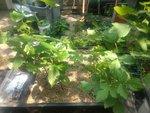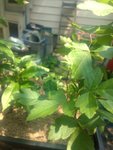Leo in N E Illinois
The Professor
- Messages
- 11,634
- Reaction score
- 24,364
- USDA Zone
- 5b
Another mixed flat, probably from 2017, Rhus aromatica, Fragrant Sumac, and Ilex verticillata, winterberry deciduous holly. This was a flat that weeding was a problem. I could not tell the seedlings from the weeds the first year or two. Also, I did not "cage" the flat, so squirrels and bird probably got the majority of seed.
Rhus aromatica is a small tree, it has male and female flowers on separate plants. The landscape industry almost exclusively sells one or two low growing, prostrate male selections, that won't seed into the landscape. But in the wild, it can become a 20 foot tall tree (exceptional) or a 5 to 10 foot tall shrub, more common. I saw the wild form when giving a talk in Kansas, and thought it had some bonsai potential. Small 3 leaflet compound leaves. A pleasant fragrance when you brush the foliage, red berries in autumn and beautiful autumn leaf color, as good as the less "bonsai friendly" sumacs. So I thought why not? and planted some seed. I only have 3 surviving seedlings, hopefully one will be female. Males are common as the prostrate landscape plant, so if I don't get a male it won't be a problem.
In the flat I also planted some Ilex verticillata seed. The Ilex took 2 years to germinate, as expected, because Ilex need a warm summer stratification followed by the usual winter stratification. I got 4 Ilex seedlings, hopefully I'll have at least one male and one female.


He, he, he, the sumac definitely looks a bit like poison ivy, now that I'm looking at a photo rather than the real thing. Poison ivy, and poison sumac are in a different, but closely related genus. I can have some fun with this, tell people I made a bonsai from poison ivy.
It is a slightly "blue-ish" leaf color on the sumac, as opposed to the normal green of poison ivy. Also leaves are lobed, rather than serrated, so the are blunt points, rather than sharp points.
Rhus aromatica is a small tree, it has male and female flowers on separate plants. The landscape industry almost exclusively sells one or two low growing, prostrate male selections, that won't seed into the landscape. But in the wild, it can become a 20 foot tall tree (exceptional) or a 5 to 10 foot tall shrub, more common. I saw the wild form when giving a talk in Kansas, and thought it had some bonsai potential. Small 3 leaflet compound leaves. A pleasant fragrance when you brush the foliage, red berries in autumn and beautiful autumn leaf color, as good as the less "bonsai friendly" sumacs. So I thought why not? and planted some seed. I only have 3 surviving seedlings, hopefully one will be female. Males are common as the prostrate landscape plant, so if I don't get a male it won't be a problem.
In the flat I also planted some Ilex verticillata seed. The Ilex took 2 years to germinate, as expected, because Ilex need a warm summer stratification followed by the usual winter stratification. I got 4 Ilex seedlings, hopefully I'll have at least one male and one female.


He, he, he, the sumac definitely looks a bit like poison ivy, now that I'm looking at a photo rather than the real thing. Poison ivy, and poison sumac are in a different, but closely related genus. I can have some fun with this, tell people I made a bonsai from poison ivy.
It is a slightly "blue-ish" leaf color on the sumac, as opposed to the normal green of poison ivy. Also leaves are lobed, rather than serrated, so the are blunt points, rather than sharp points.
Last edited:








